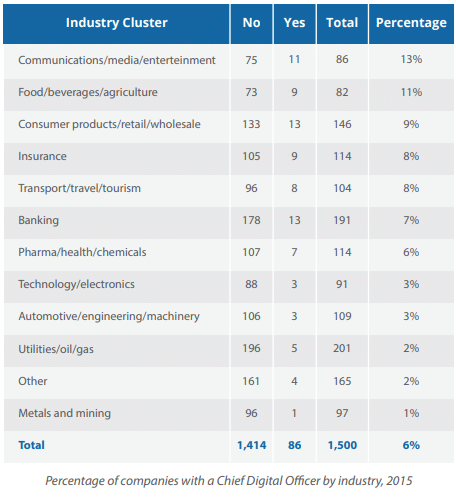Technology is “digitizing” the world around us. As Michael Baresich, Chief Information Officer at Ally Financial Group puts it: “Every company is either a technology company or a technology company in hiding.” What’s remarkable is the exponential rate of this growth: the modern cell phone has more computer power than all of NASA did in 1969 when it placed men on the moon. Going further into the past, the modern-day audio greeting card has more computer power than that of the Allied Army in World War II.
As a result, companies across industries are under pressure to integrate technology into the business model to stay relevant. Many larger companies are experiencing signicant competition from startups which offer a more specialized product and a more agile development team to respond to market demands. According to a survey of 25 senior banking executives involved in technology innovation, 72% of the respondents feel their banks have a fragmented or opportunistic approach to dealing with digital innovation, and 40% believe the time it takes their organization to deploy new technology is too slow.
There’s no doubt that companies need to embrace innovation, but how do they do it? How does this exponential rate of change affect your business? How can your company not only stay relevant and survive, but thrive in this ever-changing environment? The exponential growth in digital products, consumer data and customer interaction can allow businesses to be predictive with customer demands and issues. This mindset is crucial in order to thrive in the shifting business atmosphere–to anticipate and meet customers’ need before they even have them. As Jeff Dennes, Head of Digital Transformation at BBVA, notes, “If someone comes to BBVA’s website through cars.com and we offer them a credit card, shame on us. We should be talking to them about whether they’re buying an automobile and if we can help with a loan.”
What makes a good digital strategy?
The Chief Digital & Chief Data Officers
 The volume of business data across all companies worldwide doubles every 1.2 years. Given this growth in business and consumer data, it’s no surprise that 96% of C-level financial services executives reported having a big data initiative planned or in progress. Growth of data and digitization has required businesses to create new C-level positions to help them adapt to the new digital landscape, one of the most important being the Chief Digital Officer. The Chief Digital Officer’s primary goal is to actively manage the company’s digital assets in order to drive business value. This includes focusing on improving customer loyalty and brand loyalty by managing the company’s customer-facing platforms, such as their mobile and web content. Additionally, the Chief Digital Officer is also responsible for improving the internal business processes and IT policy to maximize efficiency.
The volume of business data across all companies worldwide doubles every 1.2 years. Given this growth in business and consumer data, it’s no surprise that 96% of C-level financial services executives reported having a big data initiative planned or in progress. Growth of data and digitization has required businesses to create new C-level positions to help them adapt to the new digital landscape, one of the most important being the Chief Digital Officer. The Chief Digital Officer’s primary goal is to actively manage the company’s digital assets in order to drive business value. This includes focusing on improving customer loyalty and brand loyalty by managing the company’s customer-facing platforms, such as their mobile and web content. Additionally, the Chief Digital Officer is also responsible for improving the internal business processes and IT policy to maximize efficiency.
In addition to the Chief Digital Officer, another crucial position in driving forward a successful digital strategy is the Chief Data Ocer, who is responsible for deriving business value from data insights. Chief Data Officers are in a very similar position to the Chief Digital Officer in the corporate ladder: they both typically report to either the CEO or CIO, and they work very closely with the directors of the strategy departments. Yet while extracting patterns and insights from big data is one of the many responsibilities of the Chief Digital Officer, it is the sole responsibility of the Chief Data Officer.
Case Study
Vail Resorts
Do you think you’re in a sector left untouched by digitization? Vail Resorts initially thought so. They considered themselves part of an industry – hospitality – very much on the physical side of the physical world/cyber world spectrum. Over time, however, they realized they were missing an opportunity to drive business value, and recently made a conscious decision to embrace digital.

Vail now classiffies their customers into three segments, as outlined by Kirsten Lynch, CMO of Vail Resorts: the “Alpine A-Listers,” those who are hard-core about skiing and luxury; the “Village Sophisticates,” who tend to care more about dining and shopping than actually skiing; and the “Shred Heads,” who are only there for the hardcore skiing. Lynch’s team knows how many days each group skis on average, what trails they ski, how they spend their money and the ROI breakdown of each segment. This consumer data is invaluable to driving their business strategy forward and has been instrumental in Do you think you’re in a sector left untouched by digitization? Vail Resorts initially thought so. They considered themselves part of an industry – hospitality – very much on the physical side of the physical world/cyber world spectrum. Over time, however, they realized they were missing an opportunity to drive business value, and recently made a conscious decision to embrace digital.
creating an effective marketing and sales strategy to their customers. They also use this information to personalize each aspect of the customer experience, right down to how resort agents address them at the front desk and throughout their trip. Early returns for this digital strategy include higher merchandise revenues and promotional sales from targeted advertising. These are the types of customer and business initiatives that are available to your business today. But in order to achieve a successful digital strategy, you need the leadership in place to do so.
What skills does a Chief Digital Officer Need?
E-commerce Expertise:
Chief Digital Officers also need product experience. If you’re going to launch an app, on what platform(s) will you launch it? How does the digital experience integrate across multiple platforms (app, website, in-store experience)? How will it be supported and enhanced over time?
Product Experience:
Chief Digital officers also need knowledge of marketing and branding. What branding resonates best with your customers? What social media outlets create the best ROI for your brand?
Marketing Experience & Social Media.
Chief Digital officers also need knowledge of marketing and branding. What branding resonates best with your customers? What social media outlets create the best ROI for your brand?
Business Savvy:
Chief Digital Officers foster a link between the CIO & CMO—as well as the CEO. They must also be able to elucidate intricate technology obstacles and solutions to both the CEO and boardroom. Yet they are more than just translators: as Faisal Masud, Chief Digital Officer of Staples notes, “The CDO is the catalyst for change in an organization. You need to bring about change within the company and ensure you’re not just serving as a technical advisor to the CEO.”
What skills does a Chief Data Officer Need?
Data Analytics Experience:
Chief Data Officers analyze large amounts of data to drive business value. What trends can you infer from sales data regarding customer demographics, times of day, geographic areas, etc.?
Data Management Experience:
Chief Data Officers are responsible for ensuring all relevant data is being captured and sorted efficiently across all systems. A 2013 Gartner survey revealed participating companies lost an average of $14.2 million annually to poor data management. This stems from duplicate accounts, lost contacts, and missed sales opportunities, among other factors.
What trends are we seeing in
Chief Digital & Chief Data Officer Hirings?
The rapid expansion of digital strategy focus has caused an exponential growth in this C-level position. The number of Chief Digital Officers has doubled every year since 2005, climbing to 2,000 Chief Digital Officers in 2015 across a variety of industries. This surge of Chief Digital Officers will only continue to accelerate as digital and big data play increasing roles in corporate strategy, as will the number of Chief Data Officers. By 2016, 30% of businesses will have begun directly or indirectly monetizing their information assets via bartering or selling them outright. Monetizing these information assets and identifying consumer insights from big data are just a few of the ways that the Chief Data Officer and Chief Digital Officer can truly drive shareholder value.
Where are these digital experts coming from? As Gavin Pathross, Chief Digital Officer of YUM! Brands notes, “Much of the top digital talent is coming from consulting firms. Take a look at Alibaba for example: they’re constantly hiring ex-McKinsey and ex-Bain executives.” Despite the obvious technological ties, compensation at top technology companies is a roadblock to attracting their digital experts to other industries. Pathross goes on to note: “Companies are struggling to find talent. It’s hard to entice the Google exec, who already has a high salary with stock options. The non-technology industries find themselves in a state of not being able to compete.”
Therefore, Chief Digital Officers don’t necessarily come from Google, Intel, or HP, but from marketing agencies that were born digital, such as Sapient Nitro, Razorfish, or Accenture’s Analytics Division, which was an exact replica of Deloitte Digital, a subdivision of Deloitte completely devoted to digital management. The common denominator of these companies and subdivisions is that these are digital by design. They’re not advertising agencies first who then try to figure out how to incorporate digital—they begin with an understanding of technology and subsequently figure out the marketing and customer experience components.
Conclusion:
Why does it all matter?
How can a good digital strategy affect your business’ bottom line? Companies that haven’t placed an emphasis on digital trail their competition by an average of 10%. Your company has an opportunity not just to catch up to your competition, but given the slow adoption of digital, to surpass them definitively. The Harvard Business Review reported that only nine companies—or less than 2% of Fortune 500 companies—have boards that are considered to be “highly digital.”
Keep in mind that it’s not just a matter of the “what” with technology, figuring out what comprises your digital strategy, it’s also a question of “who”? Neither are enough on their own. Mark Parker, the CEO of Nike, astutely notes:
“I always like to say we focus on our potential and the difference between where we are and our potential, not the distance between us and our competition. That’s where a leader should be. And as you focus on that space, you’re going to create some incredible things.”
Resources:
- Kaku, M. (2011). Physics of the future: How science will shape human destiny and our daily lives by the year 2100. New York: Doubleday.
- Crosman, P. (2014, May 13). BBVA Poaches Top Digital Bankers from Capital One, Suntrust. Retrieved May 14, 2015.
- AT Kearney, Big Data and Creative Destruction
- Bean, R. (2014, January 27). Financial Services Firms See Results from Big Data Push. Wall Street Journal.
- Gartner, The State of Data Quality: Current Practices and Evolving Trends, Ted Friedman, Saul Judah, 11 December 2013
- Logan, D., & Raskino, M. (2014, January 13). CIO Advisory: The Chief Data Officer Trend Gains Momentum. Retrieved May 8, 2015.
- Westerman, G., & Bonnet, D. (n.d.). Leading digital: Turning technology into business transformation (p. 19).
- Ibid.

